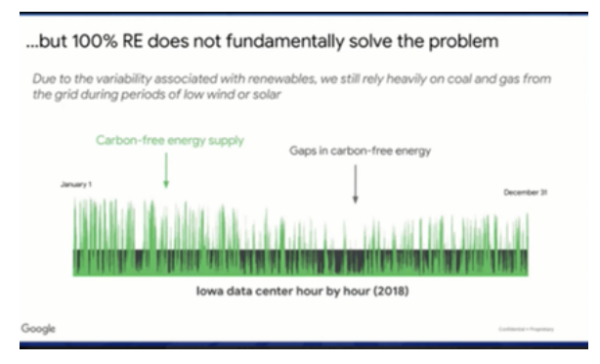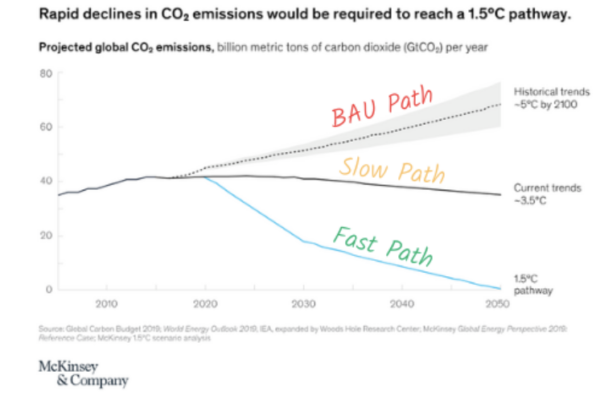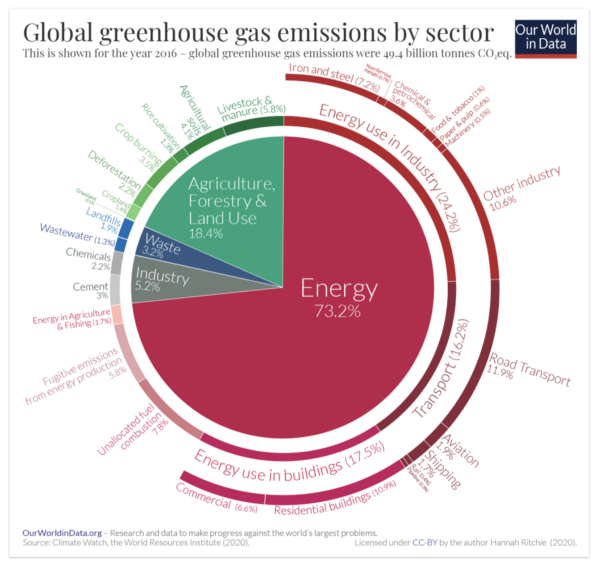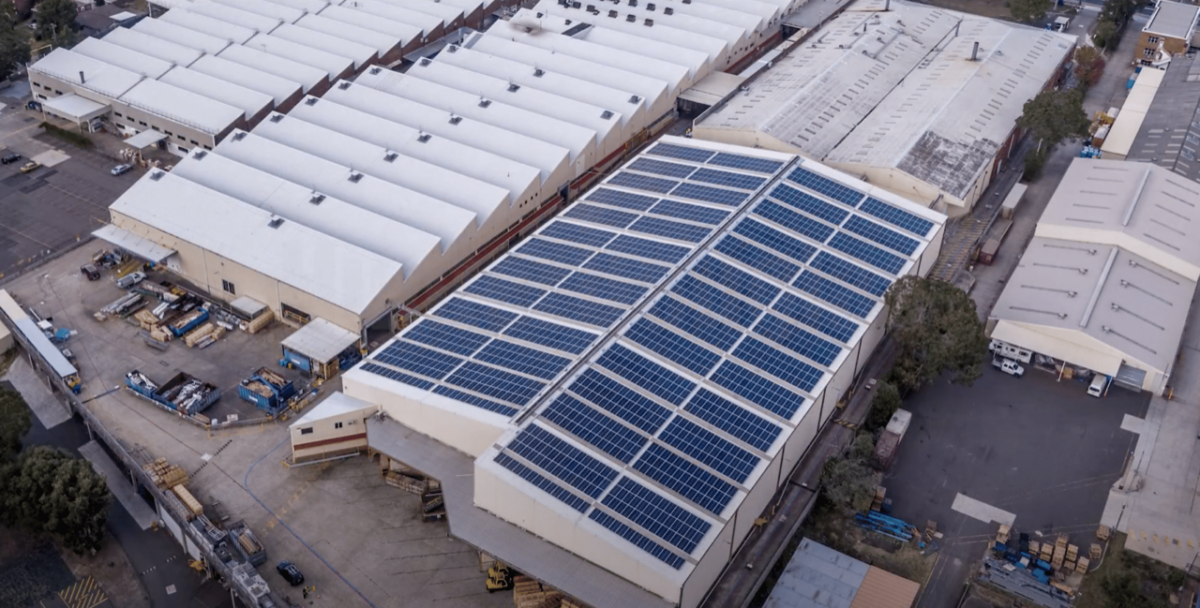In Australia, 35% of our electricity is currently from renewable sources. Yet some consumers claim their energy to be 100% renewable. How is that?
It’s done by separating the sale of electricity from the sale of its characteristics – particularly the characteristic of ‘being renewable.’ A certificate is created for each MWh of energy produced by a qualifying renewable generator, and these certificates are sold entirely independently of the energy itself.
So buyers of these certificates figure out how much energy they consume on an annual basis and buy an equivalent number of certificates, allowing them to claim that all the energy they used was renewable. However, it means that there are fewer certificates left for the rest of the market, so everyone else’s percentage renewable claim is that much less. Let’s be clear, buying certificates is paying money to take credit for renewable energy that other people used. It’s called Net Zero, and it’s time it was called out.
In 2018, a small group of Google engineers did just that, calling bullshit on the company’s claim of 100% renewable energy. By running the numbers on the wind energy matched to their data centre in Iowa they demonstrated that only 61% was sourced from clean energy. Despite their 100% clean energy claim their matched energy supplies fell 39% short, and came from burning fossil fuels.

Google reframed their ambition to 24/7 Carbon Free Energy every hour of the year for all their operations and data centres globally. This new higher standard would challenge the company as it transforms its energy procurement and daily operations to meet this higher objective by 2030.
Only 100% transparency of the clean energy source and time it is generated gives us the information we need to accelerate driving down emissions and remain on track for the max 1.5°C temperature rise we aspire to.
While Google takes on this global decarbonisation challenge for themselves, we can play a role through our actions at work and at home. Being prepared to measure and manage our own daily energy choices can contribute to the slowing of carbon emissions into the atmosphere, and can do so at a lower cost in most electricity markets around the world. Transparency builds trust and trust builds momentum for change.
How fast is fast enough?
The next ten years are critical.
Broadly speaking we have three paths: Fast, Slow and BAU.

McKinsey & Company
The McKinsey chart clearly illustrates the three path options, adapted here for illustrative purposes.
The ‘business as usual’ (BAU) Path chooses to ignore the consequences of continuing to rely on fossil fuels in our energy mix. Remaining on the BAU Path is the historical trend line making life on earth potentially untenable.
The Slow Path encourages us to believe we have time and supports the idea that Net Zero will get us where we need to be by 2050. The Slow Path is locked in an outdated paradigm of offsets and paper certificates that suggests action to an adequate energy transition. In reality this path is untenable, and as the Google analysts showed, it lacks transparency and therefore accountability.
The Fast Path achieves rapid transition by adopting electricity as our single energy source, and introducing transparency, traceability and accountability so that we can progress faster, measure our progress, and course correct where we need. It makes organisations and governments accountable and gives users the information they need to make sound choices around energy use and source.
What does a transparent fast path look like?
The Fast Path focuses on the clean electrons, bringing transparency to where carbon-free energy is being generated and consumed across the grid. The Fast Path allows us all to measure and manage our clean energy consumption upward and march fossil fuels out of our mix. Our daily climate emergency headlines reinforce the limited time we have to act. The Fast Path is a shorter journey to True Zero.
Electricity as our primary energy source is the focus for the Fast Path. In round figures energy is responsible for 75% of global emissions, when we include transport. Clean energy is the biggest lever we have to hold the line on 1.5 degrees. This is why our focus needs to be on electrifying everything, our grids, buildings and our transport, in the energy transition.

This level of transparency set Google on the Fast Path. This level of transparency meant they could see and measure where electrons were coming from. As a result, they reframed their ambition to power all data centres and operations with ‘true zero’ clean energy 24/7, every day of the year. Google is choosing the Fast Path.
Why Net Zero is no longer tenable
In the absence of tracing technology, business and government have used a combination of offsets to match against their annual emissions. Offsets have allowed advocates for Net Zero (the Slow Path) to craft a narrative that the energy transition is cheap and easy.
The narrative recognises companies emit carbon emissions during the year, these carbon emissions are totalled up and offset against a range of low-cost renewable certificates and carbon offsets. Total emissions are matched to offsets on paper and achieve a nice round 100% number.
Why is it a problem? I believe the core of the issue is the false conflation of this financial incentive system with actual measurement of renewable energy consumption. Purchasers of certificates and GreenPower are led to believe that they have hit the goal of zero carbon, but it was at the (carbon) cost of everyone else. And worryingly it leads to these net zero buyers dusting off their hands and declaring “job done.” But the job’s not done. The carbon output gets shuffled around on paper as part of the company accounting, but the underlying goal of reducing carbon emissions is not nearly as successful as we need it to be
And, by definition, we can’t all get to net zero. Net zero means paying money to take the credit for renewable energy or carbon reductions somebody else actually used. So how does that ‘somebody else’ get to net zero? It just kicks the can down the road a bit further and ultimately delays what we are really aiming for – a true zero carbon society.
So why did we do it? In a word, money. The sale of certificates goes to fund the development of new renewable generators. It’s an entirely admirable objective, but it’s past its use-by date. The certificate system began 25 years ago when renewables like solar and wind farms needed strong subsidies to compete with coal and gas. In the past quarter century however two things have changed. Firstly, the cost of solar and wind generation has dramatically fallen, becoming the lowest cost form of new generation. Secondly, all the power plants built since 1998 are still eligible for certificates, hugely watering down the impact of certificate purchases today.
The net zero Slow Path limitations are also starting to show signs of risk. Net zero champions advocate for the benefits of ‘additionality,’ only invest in new solar and wind projects and use Renewable Energy Certificates (RECs) to prove the carbon free energy generation. In principle this approach seems to make sense, if we need more clean energy in the grid, why not fund additional renewables in the dirtiest grid and get more carbon bang for our buck? In the Slow Path framework companies seek to offset their emissions by buying RECs from clean energy generated in other markets, at a lower cost. ‘Additionality’ has morphed into ‘emissionality’ and supports the development of projects outside the grid where the energy is being consumed.
Fast, Slow and BAU frameworks bring transparency to the energy transition allowing consumers to choose a path and be measured by it. If you or your organisation are doing nothing active about your energy consumption, you’re in denial. Without paying attention to the source of the energy you’re consuming, you may be unwittingly supporting the fossil fuel industry to extend its lifetime beyond the necessary transition, and socialise the cost of carbon emissions. This is a debt society will pay for dearly as our planet continues to break global temperature records month on month. If you’re buying certificates or GreenPower to sleep better at night, you may find yourself on the wrong side of history.
Ask your electricity retailer how much clean energy they are buying to match your electricity consumption, and then ask for it to be matched hour by hour. By choosing the Fast Path, by measuring and managing clean electricity entering the grid, time matched to the load in your buildings and transport, your path will stand the test of time. Your choice to buy clean energy from solar and wind farms, and big batteries charged by renewables, will be vindicated as short-term higher costs are rewarded by the long-term lower cost of clean energy.
True Zero is achievable, it’s now a question of choice. For each and every one of us, the question of which path we choose will determine which side of history we’re on. Why not ask the questions, take the Fast Path and you will find collaborators seeking to make a difference and accelerate the energy transition.
About the author
Grant McDowell is the head of strategy at enosi.energy
The views and opinions expressed in this article are the author’s own, and do not necessarily reflect those held by pv magazine.
This content is protected by copyright and may not be reused. If you want to cooperate with us and would like to reuse some of our content, please contact: editors@pv-magazine.com.








1 comment
By submitting this form you agree to pv magazine using your data for the purposes of publishing your comment.
Your personal data will only be disclosed or otherwise transmitted to third parties for the purposes of spam filtering or if this is necessary for technical maintenance of the website. Any other transfer to third parties will not take place unless this is justified on the basis of applicable data protection regulations or if pv magazine is legally obliged to do so.
You may revoke this consent at any time with effect for the future, in which case your personal data will be deleted immediately. Otherwise, your data will be deleted if pv magazine has processed your request or the purpose of data storage is fulfilled.
Further information on data privacy can be found in our Data Protection Policy.